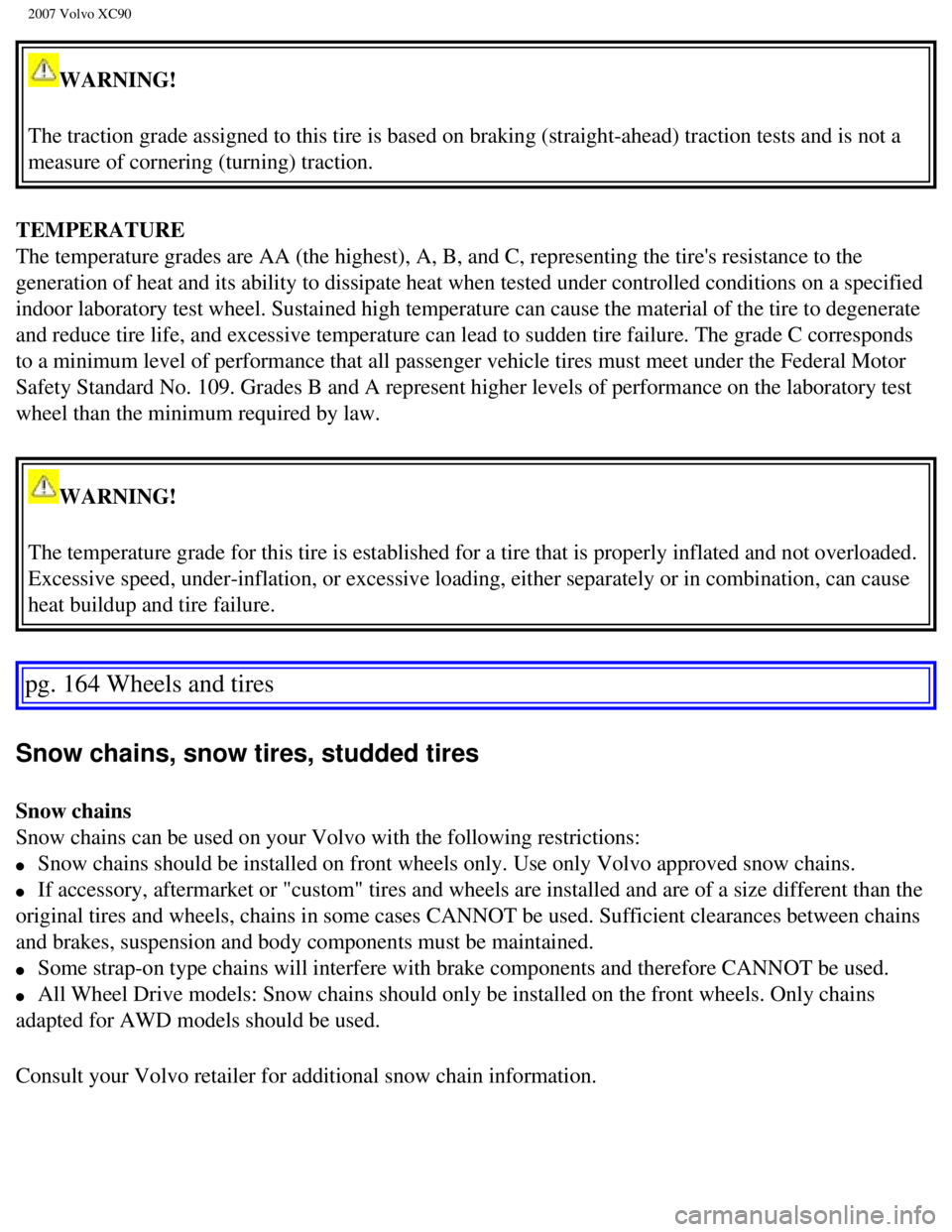2007 VOLVO XC90 tire type
[x] Cancel search: tire typePage 144 of 268

2007 Volvo XC90
Emergency towing
The towing eyelet is located in the tool bag, under the floor of the car\
go area. This eyelet must be screwed into the
positions provided on the right sides of either the front or rear bumper\
(see illustrations).
To attach the towing eyelet:
A. Use a coin to pry open the lower edge of the cover (A).
B. Screw the towing eyelet (C) in place (B), first by hand and then \
using the tire iron until it is securely in place.
After the vehicle has been towed, the eyelet should be removed and retur\
ned to the tool bag. Press the cover back into
position.
Precautions when the vehicle is in tow
l The steering wheel must be unlocked. Turn the ignition key to position I\
or II.
l The gear selector must be in position N.
l Maximum speed: 50 mph (80 km/h). Do not exceed the maximum allowable t\
owing speed.
l Maximum distance with front wheels on ground: 50 miles (80 km).
l While the vehicle is being towed, try to keep the tow rope taut at all t\
imes.
l The vehicle should only be towed in forward direction.
CAUTION!
- Please check with state and local authorities before attempting this t\
ype of towing, as vehicles being towed are subject
to regulations regarding maximum towing speed, length and type of towing\
device, lighting, etc.
- If the vehicle's battery is dead, do not attempt to start the vehicle \
by pushing or pulling it as this will damage the three-
way catalytic converter(s). The engine must be jump started using an a\
uxiliary battery (see
page 136).
- If the vehicle is being towed on a flat bed truck, the towing eyelets \
must not be used to secure the vehicle on the flat
bed. Consult the tow truck operator.
pg. 135 Starting and driving
Towing
file:///K|/ownersdocs/2007/2007_XC90/07xc90_06.htm (20 of 32)12/30/200\
6 5:53:44 PM
Page 151 of 268

2007 Volvo XC90
Load carrier cover
The vehicle's ignition key or the stud on the edge of the supplied torqu\
e wrench can be used to undo or tighten the cover.
Turn a quarter turn (90 degrees). See illustration.
pg. 143 Starting and driving
Cold weather precautions
If you wish to check your vehicle before the approach of cold weather, t\
he following advice is worth noting:
l Make sure that the engine coolant contains 50 percent antifreeze. Any ot\
her mixture will reduce freeze protection. This
gives protection against freezing down to -31°F (-35°C). See sec\
tion "Coolant". The use of "recycled" antifreeze is not
approved by Volvo. Different types of antifreeze must not be mixed.
l Volvo recommends using only genuine Volvo antifreeze in your vehicle's r\
adiator. Your Volvo retailer stocks plenty of
Volvo engine coolant to protect your vehicle during cold weather.
l Try to keep the fuel tank well filled - this prevents the formation of condensation in the tank. \
In addition, in extremely
cold weather conditions it is worthwhile to add fuel line de-icer before\
refueling.
l The viscosity of the engine oil is important. Oil with low viscosity (thinner oil) improves cold-weat\
her starting as well
as decreasing fuel consumption while the engine is warming up. For winte\
r use, 5W-30 oil, particularly the synthetic type
1,
is recommended. Be sure to use good quality oil but do not use cold-weat\
her oil for hard driving or in warm weather. See
section "Engine oil" for more information.
l The load placed on the battery is greater during the winter since the windshield wipers, lighting, etc\
. are used more
often. Moreover, the capacity of the battery decreases as the temperatur\
e drops. In very cold weather, a poorly charged
battery can freeze and be damaged. It is therefore advisable to check th\
e state of charge more frequently and spray an
antirust oil on the battery posts.
l Volvo recommends the use of snow tires on all four wheels for winter driving - see section "Wheels and tires."\
l To prevent the washer fluid reservoir from freezing, add washer solvents containing antifreeze (see page 188 for the
location of the washer fluid reservoir). This is important since dirt i\
s often splashed on the windshield during winter
driving, requiring the frequent use of the washers and wipers. Volvo Was\
her Solvent should be diluted as follows:
- Down to 14° F (-10° C): 1 part washer solvent and 4 parts water
- Down to 5° F (-15° C): 1 part washer solvent and 3 parts water
- Down to 0° F (-18° C): 1 part washer solvent and 2 parts water
- Down to -18° F (-28° C): 1 part washer solvent and 1 part water
l Use Volvo Teflon Lock Spray in the locks.
NOTE: Avoid the use of de-icing sprays as they can cause damage to the locks.
file:///K|/ownersdocs/2007/2007_XC90/07xc90_06.htm (27 of 32)12/30/200\
6 5:53:44 PM
Page 158 of 268

2007 Volvo XC90
holding on icy or snow-covered roads, we recommend suitable winter tires\
on all four wheels.
When replacing tires, be sure that the new tires are the same size desig\
nation, type (radial) and
preferably from the same manufacturer, on all four wheels. Otherwise the\
re is a risk of altering the
vehicle's roadholding and handling characteristics.
Storing wheels and tires
When storing complete wheels (tires mounted on rims), they should be s\
uspended off the floor or placed
on their sides on the floor.
Tires not mounted on rims should be stored on their sides or standing up\
right, but should not be
suspended. CAUTION!
Tires should preferably be stored in a cool, dry, dark place, and should\
never be stored in close
proximity to solvents, gasoline, oils, etc.
Tread wear indicator
The tires have wear indicator strips running across or parallel to the t\
read. The letters TWI are printed on
the side of the tire. When approximately 1/16" (1.6 mm) is left on the\
tread, these strips become visible
and indicate that the tire should be replaced. Tires with less than 1/16\
" (1.6 mm) tread offer very poor
traction.
When replacing worn tires, it is recommended that the tire be identical \
in type (radial) and size as the
one being replaced. Using a tire of the same make (manufacturer) will \
prevent alteration of the driving
characteristics of the vehicle.
pg. 151 Wheels and tires
file:///K|/ownersdocs/2007/2007_XC90/07xc90_07.htm (2 of 23)12/30/2006\
5:53:47 PM
Page 168 of 268

2007 Volvo XC90
pg. 160 Wheels and tires
Glossary of tire terminology
l Tire information placard: A placard showing the OE (Original Equipment) tire sizes, recommende\
d
inflation pressure, and the maximum weight the vehicle can carry.
l Tire Identification Number (TIN): A number on the sidewall of each tire providing information
about the tire brand and manufacturing plant, tire size and date of manu\
facturer.
l Inflation pressure: A measure of the amount of air in a tire.
l Standard load: A class of P-metric or Metric tires designed to carry a maximum load a\
t 35 psi [37
psi (2.5 bar) for Metric tires]. Increasing the inflation pressure bey\
ond this pressure will not increase the
tires load carrying capability.
l Extra load: A class of P-metric or Metric tires designed to carry a heavier maximu\
m load at 41 psi
[43 psi (2.9 bar) for Metric tires]. Increasing the inflation pressure\
beyond this pressure will not increase
the tires load carrying capability.
l kPa: Kilopascal, a metric unit of air pressure.
l PSI: Pounds per square inch, a standard unit of air pressure.
l B-pillar: The structural member at the side of the vehicle behind the front door\
.
l Bead area of the tire: Area of the tire next to the rim.
l Sidewall of the tire: Area between the bead area and the tread.
l Tread area of the tire: Area of the perimeter of the tire that contacts the road when mounted \
on the
vehicle.
l Rim: The metal support (wheel) for a tire or a tire and tube assembly upo\
n which the tire beads are
seated.
l Maximum load rating: a figure indicating the maximum load in pounds and kilograms that can \
be
carried by the tire. This rating is established by the tire manufacturer\
.
l Maximum permissible inflation pressure: the greatest amount of air pressure that should ever be
put in the tire. This limit is set by the tire manufacturer.
l Recommended tire inflation pressure: inflation pressure, established by Volvo, which is based on
the type of tires that are mounted on a vehicle at the factory. This inf\
lation pressure is affected by the
number of occupants in the vehicle, the amount of cargo, and the speed a\
t which the vehicle will be
driven for a prolonged period. This information can be found on the tire\
inflation placard(s) located on
the driver's side B-pillar or on the inside of the fuel filler door on C\
anadian models, and in the tire
inflation table in this chapter.
l Cold tires: The tires are considered to be cold when they have the same temperatur\
e as the
surrounding (ambient) air. This temperature is normally reached after \
the vehicle has been parked for at
least 3 hours.
pg. 161 Wheels and tires
Vehicle loading
file:///K|/ownersdocs/2007/2007_XC90/07xc90_07.htm (12 of 23)12/30/200\
6 5:53:47 PM
Page 171 of 268

2007 Volvo XC90
WARNING!
The traction grade assigned to this tire is based on braking (straight-\
ahead) traction tests and is not a
measure of cornering (turning) traction.
TEMPERATURE
The temperature grades are AA (the highest), A, B, and C, representing\
the tire's resistance to the
generation of heat and its ability to dissipate heat when tested under c\
ontrolled conditions on a specified
indoor laboratory test wheel. Sustained high temperature can cause the m\
aterial of the tire to degenerate
and reduce tire life, and excessive temperature can lead to sudden tire \
failure. The grade C corresponds
to a minimum level of performance that all passenger vehicle tires must \
meet under the Federal Motor
Safety Standard No. 109. Grades B and A represent higher levels of perfo\
rmance on the laboratory test
wheel than the minimum required by law.
WARNING!
The temperature grade for this tire is established for a tire that is pr\
operly inflated and not overloaded.
Excessive speed, under-inflation, or excessive loading, either separatel\
y or in combination, can cause
heat buildup and tire failure.
pg. 164 Wheels and tires
Snow chains, snow tires, studded tires
Snow chains
Snow chains can be used on your Volvo with the following restrictions:
l Snow chains should be installed on front wheels only. Use only Volvo app\
roved snow chains.
l If accessory, aftermarket or "custom" tires and wheels are installed and\
are of a size different than the
original tires and wheels, chains in some cases CANNOT be used. Sufficie\
nt clearances between chains
and brakes, suspension and body components must be maintained.
l Some strap-on type chains will interfere with brake components and there\
fore CANNOT be used.
l All Wheel Drive models: Snow chains should only be installed on the fron\
t wheels. Only chains
adapted for AWD models should be used.
Consult your Volvo retailer for additional snow chain information.
file:///K|/ownersdocs/2007/2007_XC90/07xc90_07.htm (15 of 23)12/30/200\
6 5:53:47 PM